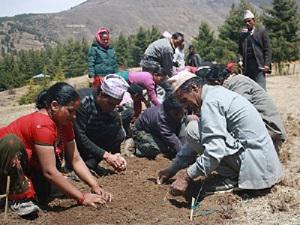Mohan Dev Joshi
Other projects
30 Mar 2016
Working with Community to Improve Livelihoods and Enhance Conservation of Paris polyphylla
The major aim of this work is to support fulfilling the policy-practice gap for onsite conservation and sustainable management of Paris polyphylla by accessing population biology, spatial distribution and abundance, existing threats and awareness and understanding of local stakeholders.

Field practice training.
Paris polyphylla (Local name ‘Satuwa’; Family: Trilliaceae/Melanthiaceae), is a understorey perennial herb with 40-70cm height, a whorl of 4-9 dark-green lanceolate leaves at the top of the stem, and creeping rhizomes. The species, with enormous medicinal and socio-cultural importance, is distributed from North-West India to Myanmar; and in Nepal Himalaya, reported from west to east within an altitudinal range of 1800-3300m a.s.l. (IUCN 2004). The species has been identified as ‘Vulnerable’ in Nepal by IUCN and CAMP (CAMP 2001, IUCN 2004). However, Forest act 1993 of Nepal has permitted the licensed trade of its rhizomes.

A local women collecting Paris tubers.
We predict that although Paris polyphylla is well distributed in Himalayan region, its local population in Api-Nampa Conservation Area (ANCA) is declining continuously at an alarming rate by human interference such as unsustainable harvesting (over- and premature- collection), unscientific use, illegal/cross-border trade of rhizomes, habitat destruction, overgrazing, forest-fire, and soil-erosion. In addition, it is inherently slow-growing and poorly regenerating species due to dormancy of its seeds and rhizomes, and its restricted local distribution (Vassilopoulos 2009; K.C. et al. 2010); thus, an important species meriting conservation.
A total of 36 belt transects of size 210m x 20m at four different sites in the ANCA will be laid subjectively, 9 at each site. Assessment of demography, distribution pattern, and conservation threats will help to launch appropriate conservation measures. Science-based conservation awareness program and guidelines will be crucial for the proper management of threatened species. Various threats to Paris polyphylla will be ascertained by questionnaires, interviews, and focused group discussions with the local stakeholders as well as by field sampling.
This project will conduct different approaches to raise public awareness about the importance of the species, the trend, causes and consequences of its declining population, and need for its conservation and management. Seminars and workshops will be carried in the communities including peoples of different age groups, local healers, and cultural/religious groups. At least four community-based conservation groups, one in each site, will be formed and trained for building/enhancing their biodiversity conservation, management, and monitoring capacity. The target species conservation-oriented classes along with essay and art completion will be conducted for students as well as teachers in schools. Poster and leaflets will be used as teaching materials.